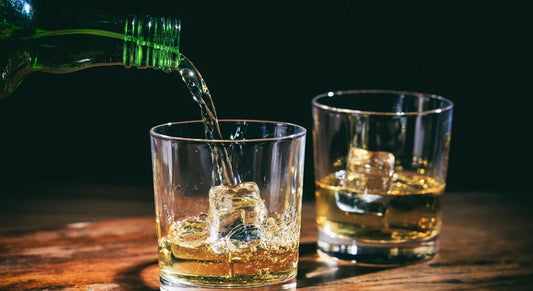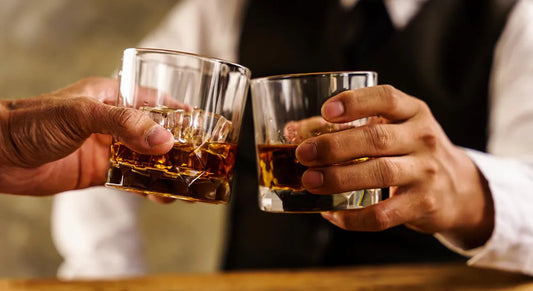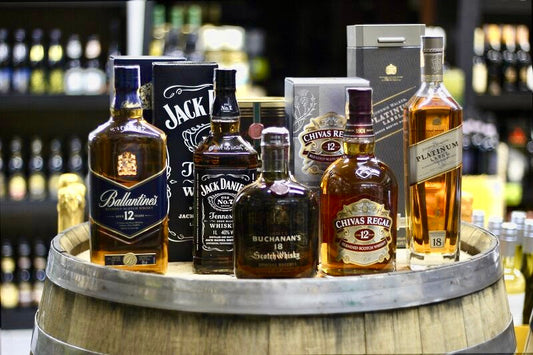
Master the Art of Whisky Tasting - An Expert's Step-by-Step Guide to Appreciating the Subtle Flavours and Aromas
Whisky is a fascinating spirit with a rich history and a unique production process around the world. Each type of whisky, whether it's Scotch or Bourbon, has its own special aroma and flavor that leaves us wanting more.
Sometimes, distilleries don't sell small bottles of whisky, and buying a regular-sized bottle can take months to finish even with friends helping you out. Luckily, some liquor sellers offer repackaged drinks in smaller sizes, perfect for savouring one glass at a time and not having to wait long to consume it. As you may know, at Liquor Loot we sell whisky tasting packs with three 60ml bottles from different distilleries, a perfect way to explore different flavour profiles. There are also whisky-tasting events where you can sample different whiskies from different distilleries. Such online stores and whisky events allow us to experience the world of whisky and learn diverse tastes without going over the budget or wasting excess drinks.
Learning the art of whisky tasting involves analyzing and appreciating the different flavours and aromas present in different types of whisky. Prepare your nose, tongue, and preferably the aromatic side of your brain to smell, taste, and analyze the characteristics of whisky. Whisky connoisseurs love this activity because it helps them fully appreciate and understand the complexities of this beloved spirit, enhancing their overall enjoyment. The best part is that you can do it on your own, with friends, or with other whisky lovers.
Preparing for Whisky Tasting
Choosing the glassware
Getting ready for a whisky tasting means you need the right glassware. A Glencairn glass is like the holy grail for whisky tastings, but any glass with a tulip shape will do the trick. Why tulip-shaped, you ask? Well, it's because this shape helps focus the whisky's smell right at the top of the glass. The wide bowl gives the whisky some room to breathe and lets the aroma work its magic. Then, the narrowing at the top keeps all those lovely smells in one spot, making it way easier to enjoy everything the whisky has to offer. Oh, and the stem? It's there so you can hold the glass without accidentally warming up your drink.
Choosing the right whisky
 The quest for the elusive perfect whisky is like searching for a needle in a haystack, except the haystack is full of delicious bottles of golden nectar. By understanding your own preferences, researching the differences between types of whisky, and taking into account the occasion and budget, you and other whisky enthusiasts can make an informed decision when selecting a bottle to enjoy. Keep in mind that whisky tasting is all about exploring and trying new things, so go out there and have fun trying all sorts of whiskies in this huge, awesome world of whisky goodness.
The quest for the elusive perfect whisky is like searching for a needle in a haystack, except the haystack is full of delicious bottles of golden nectar. By understanding your own preferences, researching the differences between types of whisky, and taking into account the occasion and budget, you and other whisky enthusiasts can make an informed decision when selecting a bottle to enjoy. Keep in mind that whisky tasting is all about exploring and trying new things, so go out there and have fun trying all sorts of whiskies in this huge, awesome world of whisky goodness.The Art of Whisky Tasting
-
Let the whisky sit: When you first pour whisky into a glass, the aromas, and flavours can be somewhat subdued due to the high alcohol content. Allowing the whisky to sit in the glass for a few minutes before tasting gives it time to breathe and allows the aromas and flavours to open up. This can enhance your tasting experience and make it easier for you to appreciate the full range of characteristics of whisky. Moreover, letting the whisky sit for a bit takes the edge off the alcohol.
-
Appreciate the colour: Take a moment to appreciate the colour of the whisky. The colour can indicate the type of cask it was aged in and how long it was aged. Older whiskies usually have a darker colour, while younger ones might look more like pale gold or straw. But don't just rely on the colour to tell you everything – sometimes caramel colouring is added to whiskies to change their look. Wanna know the age for sure? Just read the label – it'll usually say how many years the whisky's been ageing.
-
Add a few drops of water: If you want to level up your whisky game, adding a few drops of water to the whisky can help release the hidden
aromas and flavours. It helps lessen the harshness of alcohol and opens up the flavours. It helps activate the whisky's natural oils making the whisky feel smoother in your mouth. But don't go overboard – just a few drops will do the trick because adding too much can make the whisky lose some of its complexity and richness.

-
Nose the whisky: Gently swirl the whisky first to create a vortex in the glass that allows the liquid to mix with air and release its aromas. When you are ready to nose, hold the glass by the stem or base so you don’t warm the whisky with your hand. Bring the glass to your nose and take a gentle whiff with your mouth a bit open, letting some air mix with the whisky. Catch that first scent, and then swirl the whisky around again. Go in for another sniff, but get your nose a little closer to the glass this time. See if you can pick up different smells like fruit, spices, or smoke. Also, pay attention to how strong the smells are – that can tell you something about the whisky's age and strength.
-
Taste the whisky: Take your time through the tasting process. Allow each flavour to develop and evolve on your palate. Savour the moment and let the whisky reveal its complexity to you at its own pace. Give the whisky a lil' swish around your mouth so it covers your whole tongue and helps you catch all those tasty notes. Notice how the flavour change from the front to the back of your mouth and if there's any cool texture or mouthfeel going on. It's all part of the experience!
Want to unlock even more flavour? Breathe in through your nose while the whisky's still chilling in your mouth – it can help reveal hidden tastes and smells. If you're trying a bunch of whiskies, remember to take small sips and give your palate a quick cleanse between each one with some water or a bite of a plain, unsalted cracker. This way, you won't get flavour overload and your taste buds will stay fresh and ready for more.
Follow along with a whisky tasting pack to sharpen your nose and palate.
Evolution of Whisky Taste on Your Own Taste Buds

As whisky touches your palate, you often notice several different notes that change and evolve as you let it lather your tongue. These changes can be broken down into a few stages:
- Front palate: This is the initial taste you get when the whisky first hits your tongue. You might experience sweet or fruity flavour at this stage, like vanilla, honey, or citrus.
- Mid-palate: As the whisky moves to the middle of your tongue, you may start to taste more complex flavours. This could include spices, nuttiness, or richer fruit flavours like dried fruits or dark berries.
- Back palate: As the whisky reaches the back of your tongue and you start to swallow, you'll often notice deeper, more intense flavours. This is where you might find smoky, peaty, or woody notes, as well as some bitterness or warmth from the alcohol.
Getting up close and personal with all these flavours helps you see why each whisky is special. Jotting down what you notice can be super helpful, especially if you're trying out a few different whiskies or working on leveling up your tasting skills.
Common Whisky Flavours and Aromas
The most common flavours and aromas found in whisky
Do you wanna know what flavours and aromas you can expect from a glass of whisky? Depending on the type of whisky you’re drinking, you can pick up different flavours and aromas. These were influenced by different factors during the production process like ingredients, region, climate, and technique. As the demand for whisky grows, distilleries around the world are experimenting with different techniques to craft that perfect taste and aroma.
One of the most common flavours you'll find in whisky is vanilla, which can give it a sweet and smooth taste. You might also notice some notes of caramel or toffee, which can add a bit of richness and depth to the flavour. The country that is most famous for distilling whisky with is the United States. This flavour profile is often associated with American bourbons, which are made from at least 51% corn and aged in charred oak barrels.
Another common aroma you might detect in whisky is a smoky or peaty scent. This is particularly true of Scottish whiskies, which often use peat to dry the malted barley. The smokiness can give the whisky a really distinct flavour that some people absolutely love.
Of course, there are plenty of other flavours and aromas you might pick up on when you're sipping whisky. Some people might detect fruity notes like apple or pear, while others might pick up on hints of spice like cinnamon or nutmeg. It really just depends on the whisky and your own personal palate.
How to identify these flavours and aromas

Picking up the flavours and aromas of your whisky drink elevates the experience in enjoying it. Knowing the different smells and tastes will also help you narrow down your preference and makes it easy for you to seek out that perfect whisky bottle. If you're wondering how to identify those flavours and aromas, let me share with you a few tips and tricks that might help you out.
When you're sipping on some whisky, the first thing you'll wanna do is give it a good sniff. Take a few whiffs and see if any particular scents stand out. If you wanna really get the full effect, try tilting your glass a bit to let those aromas hit your nose.
Once you've taken in the aroma, go ahead and take a sip. Let it sit on your tongue for a few seconds and let those flavours develop. As you're tasting, see if you can pick out any of the same flavours you noticed in the scent.
Now, if you're new to whisky tasting, putting a name to those flavours can be tough. That's where a "tasting flight" or tasting pack from liquorloot.com can come in handy - just try a few different whiskies side by side to compare and contrast the flavours.
And if you really wanna be in the know, it can help to read up on the different types of whiskies and what flavours and aromas are common to each. That way, you'll know what to expect before you even take that first sip!
Pairing Whisky with Food
The principles of pairing whisky with food

Pairing whisky with food can be a super fun way to bring out the best in both the drink and the dish. Here are a few principles to keep in mind if you're looking to try your hand at whisky and food pairing:
- Consider the flavour profile of the whisky: Just like with wine, different types of whiskies will have different flavour profiles that might pair better with certain foods. For example, a smoky and peaty whisky might pair well with grilled or smoked meats, while a sweeter whisky might be a nice complement to a dessert.
- Look for complementary flavours: When pairing whisky with food, you'll want to look for flavours that complement each other. For example, a whisky with notes of honey and vanilla might pair well with a dish that features those same flavours.
- Don't be afraid to contrast: That said, sometimes contrasting flavours can work really well together too! A spicy whisky might be a great pairing for a creamy or cheesy dish, for example.
- Think about the weight of the dish: In general, you'll want to pair heavier, richer whiskies with heartier dishes, and lighter whiskies with lighter dishes. This will help balance out the flavours and ensure that neither the whisky nor the food overwhelms the other.
- Experiment and have fun: At the end of the day, the most important thing is to experiment and find what works for you. There are no hard and fast rules when it comes to pairing whisky with food, so don't be afraid to get creative and have fun with it!
The best foods to pair with different types of whisky.
If you're looking to pair different types of whisky with some tasty eats, here are some ideas to get you started:
- Bourbon whiskey: Since bourbon is often sweeter and more caramel-y than other types of whisky, it can be a great match for barbecue or grilled meats. Think pulled pork, ribs, or even a nice steak. Bourbon can also pair well with desserts that feature caramel or vanilla, like crème brûlée or bread pudding.
- Irish whisky: Irish whisky tends to be a bit smoother and lighter than the other types of whisky, so it can be a nice match for seafood or lighter pasta dishes. It can also be a great match for cheeses like cheddar or gouda.
- Scotch Whisky: Scotch can be a bit smokier and peatier than other types of whisky, so it can be a great match for dishes that feature those same flavours. Think smoked salmon, grilled meats, or even smoked cheeses. Scotch can also be a great match for dark chocolate.
- Rye whisky: Rye whisky tends to be spicier than other types of whisky, so it can be a great match for bold, flavour dishes like chilli or spicy fried chicken. It can also be a nice match for strong, tangy cheeses like blue cheese.
- Japanese whisky: Japanese whisky is often smooth and subtle, with notes of honey and fruit. It can be a great match for sushi or other Japanese cuisine, as well as for dishes that feature ginger or soy sauce.
Conclusion:
Applying this guide to your whisky-tasting journeys will make you look like a pro (even if you're not trying to be one). By memorising or documenting your taste impressions, you can compare and contrast different whiskies, better understand your personal preferences, and track your progress as your palate becomes more refined.
Take time in enhancing this skill. Make it more meaningful by involving your friends and loved ones. You can showcase your new talent by inviting them for a drink or a meal with a whisky of your choice because it fits the occasion.
If you want to try a tasting adventure, head on over to Liquor Loot for our whisky tasting packs with three 60ml bottles from different distilleries. It's a perfect way to explore different flavour profiles. Cheers!













